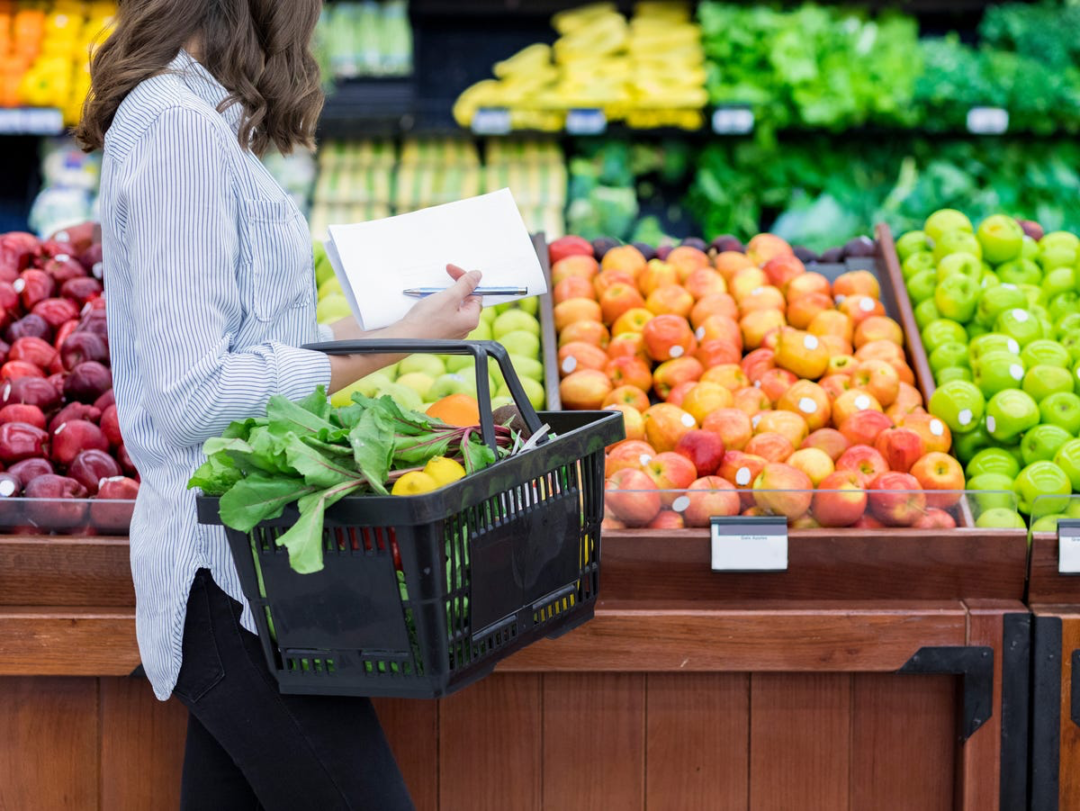Why Food Prices Are Rising in 2025

Thanks to rising inflation and new tariffs affecting imported goods, grocery prices are higher than ever. Essentials like produce, grains, and meat are no longer as affordable as they once were.
This makes it more important than ever to plan your meals carefully, shop smart, and focus on nutrient-dense, affordable foods to stay healthy without breaking your wallet. Healthy eating on a budget is getting harder to do but there is still hope with proper planning.
What Does “Healthy Eating on a Budget” Really Mean?
Healthy eating on a budget isn’t about buying the cheapest food possible — it’s about getting the most nutrition per dollar.
Choosing smart, filling foods keeps your body fueled and saves you money in the long run.
What Are Nutrient-Dense Foods (and Why They Matter)?

Nutrient-dense foods provide a high amount of vitamins, minerals, and essential nutrients without excess calories.
When budgeting, these foods are your best investment because they nourish you properly and keep you feeling full longer.
Examples of nutrient-dense foods:
- Beans (avg. $1.25/lb dry)
- Brown rice (avg. $1.50/2 lb bag)
- Chicken thighs (avg. $2.49/lb)
- Liver (avg. $1.99/lb)
- Fresh carrots (avg. $0.89/lb)
- Canned tuna (avg. $1.00–$1.25/can)
These foods pack a punch compared to empty-calorie junk foods that leave you hungry an hour later.
Special Mention:

- Chicken is one of the most affordable and versatile meats you can buy. Chicken thighs especially stay juicy, are easy to cook in bulk, and cost less than many plant-based proteins!
- Liver is an underrated superfood. It’s loaded with iron, vitamin A, B vitamins, and high-quality protein—perfect for budget shoppers focused on health. Liver isn’t everyone’s favorite in terms of taste, but it’s hard to beat for nutrition and value.
The Fiber Factor: Fullness That Saves You Money
High-fiber foods keep you full longer and stabilize your blood sugar, helping you eat less throughout the day.
This means fewer snack cravings and more bang for your buck. High fiber food sources are essential for healthy eating on a budget.
Top fiber-rich budget foods:
- Oats (avg. $3.50 for 42 oz tub)
- Lentils (avg. $1.29/lb dry)
- Broccoli (avg. $1.99/lb)
- Sweet potatoes (avg. $0.99/lb)
Building meals around fiber helps you stay satisfied and reduces the need for expensive snacks.
Full Day of Budget-Friendly Eating (Cost Breakdown)
Here’s an example of a full day of eating healthy on a budget:
| Meal | Food | Estimated Cost |
|---|---|---|
| Breakfast | Oatmeal with peanut butter and banana | $1.00 |
| Snack | Apple and a handful of almonds | $1.50 |
| Lunch | Chicken thigh (grilled), brown rice, broccoli | $3.00 |
| Snack | Greek yogurt (plain, small cup) | $1.00 |
| Dinner | Beef liver stir-fry with mixed veggies | $2.50 |
Total: ~$9.00–$10.00/day
That’s less than many fast food meals — but packed with nutrients!
The Trap of “Cheap” Foods (and Why They Actually Cost More)

Sure, a box of sugary cereal or a two-liter soda might seem like a bargain.
But these foods are low in nutrition, spike your blood sugar, and leave you hungry again within hours.
More hunger = more spending + more calories = potential weight gain.
It’s a vicious (and expensive) cycle.
Choosing whole foods keeps you fuller, healthier, and spending less over time.
Why Water Is Your Secret Weapon

Soda and sugary drinks not only cost money, but they also add empty calories.
Water, on the other hand, is free (or close to it) and helps curb your appetite naturally after meals.
Staying hydrated makes you feel more energized, improves digestion, and keeps cravings at bay.
Pro Tip:
Drink a glass of water 15 minutes before each meal to boost fullness naturally and avoid unnecessary snacking.
💬 Interested in learning more about how drinking water can boost your energy, aid fat loss, and improve mental focus? Let us know in the comments below! We’re working on a full article dedicated to the benefits of hydration—coming soon.
Sample Budget Grocery List for Healthy Eating
Here’s a shopping list to get you started:
- Brown rice (2 lb bag) – $1.50
- Dried lentils (1 lb bag) – $1.29
- Oats (42 oz tub) – $3.50
- Frozen broccoli (1 lb) – $2.00
- Chicken thighs (per lb) – $2.49
- Beef liver (per lb) – $1.99
- Canned tuna (each) – $1.00
- Peanut butter (16 oz jar) – $2.29
- Bananas (per lb) – $0.69
- Sweet potatoes (per lb) – $0.99
- Greek yogurt (plain) – $1.00 each
- Bulk almonds (1 lb) – $5.99
Total estimate: around $25–$30 for several days of healthy meals.
✅ Pro Tip: Check out Amazon for bulk pantry items like oats, rice, and canned tuna. Save money here with our favorite deals!
Where’s the best place to shop for healthy eating on a budget?
Amazon for shelf-stable pantry items
Aldi, Lidl, or other discount grocers
Bulk stores like Costco or Sam’s Club
Local farmers markets
Amazon Items That Help You Save on Food
Want to stretch your budget even further?
Here are a few useful items you can grab on Amazon:
Meal Prep Containers (Amazon) – Stretch leftovers and cut food waste
Bulk Grains Storage Bins (Amazon) – Keep rice, oats, and beans fresh longer
Slow Cooker (Amazon) – Create big batches of meals effortlessly
Budget Kitchen Scale (Amazon) – Avoid overeating and wasted ingredients
Reusable Grocery Bags (Amazon) – Save on plastic bag fees and be eco-friendly
As an Amazon Associate, we earn from qualifying purchases at no extra cost to you.” Thank you for supporting ACG Fitness!
⚠️ Common Mistakes Beginners Make (And Fixes)
❌ Buying “diet” junk food
Processed health foods like vegetable chips can be overpriced and under-nourishing. Don’t fall for the trap
❌ Skipping meals to save money
This often leads to binge eating later. Instead, focus on filling meals using high-fiber carbs and protein.
❌ No grocery plan = wasted food
Always shop with a list and purpose to avoid throwing away food (and money).
Frequently Asked Questions (FAQ)
How can I eat healthy on a tight budget?
Focus on nutrient-dense, high-fiber foods like beans, rice, oats, frozen veggies, chicken, and liver. Plan your meals, shop sales, and buy in bulk when possible.
What are some cheap healthy meals?
Oatmeal with peanut butter, rice and beans, chicken and broccoli stir-fry, liver and veggie stir-fry, and tuna salad are all healthy, affordable meal ideas.
Why should I avoid soda and sugary cereals?
These foods spike your blood sugar, leave you hungry faster, and add extra calories that make you gain weight — ultimately costing you more money in the long run.
Is chicken still an affordable protein?
Yes! Chicken thighs especially remain a budget-friendly, versatile protein option. They cost about $2.49/lb and can be baked, grilled, or shredded into meals.
Why should I consider eating liver?
Liver is extremely affordable (around $1.99/lb), packed with protein, iron, and vitamins like A and B12. It may not taste amazing, but it’s a nutritional powerhouse for budget eaters.
Q: Why are food prices so high right now?
A: Food prices have increased due to a combination of factors like inflation, global supply chain disruptions, and tariffs on imported goods. These costs get passed down to consumers at the grocery store. That’s why it’s more important than ever to focus on cost-effective, nutrient-dense foods that deliver more value per dollar.
Q: How can drinking water help save money and improve my diet?
A: Water is not only free or very inexpensive, but it also helps curb hunger, boosts metabolism, and improves digestion. Swapping out sodas and sugary drinks for water can save you hundreds of dollars a year. Stay tuned for our upcoming blog post on the benefits of drinking more water! 💧
Q: What foods are still affordable despite inflation?
A: Foods like oats, dried beans, brown rice, frozen vegetables, canned tuna, chicken thighs, and beef or chicken liver remain relatively affordable. These items offer a lot of nutrition for the price and should be staples for healthy eating on a budget shopping list.
Q: How can I avoid overspending on groceries during high inflation?
A: Create a weekly meal plan before shopping, stick to a grocery list, buy in bulk when prices are good (especially for staples like rice, oats, and canned goods), and avoid impulse purchases. Also, skip high-priced convenience foods and sugary snacks that add little nutritional value but drain your budget faster.
Q: Is eating processed foods actually more expensive long-term?
A: Absolutely. While processed foods like soda, sugary cereals, and chips may seem cheaper upfront, they leave you hungry sooner because they lack fiber and essential nutrients. This leads to eating (and buying) more food, adding hidden costs over time — not to mention the health costs from poor nutrition.
Q: Are there cheap, healthy protein sources other than eggs?
A: Yes! Chicken thighs, canned tuna, dried lentils, cottage cheese, and beef or chicken liver are excellent, budget-friendly protein sources. Liver, in particular, is nutrient-dense and very affordable — making it a smart choice during times of rising food costs.
Final Thoughts: Healthy Eating on a Budget Is Possible
Eating healthy while saving money takes planning and smart choices — but it’s absolutely doable.
Focus on nutrient-dense foods, cook at home, stay hydrated, and avoid falling into the junk food trap.
Your wallet (and your waistline) will thank you. Check out our articles about the best protein bars and top premade protein shakes you can buy as well. Protein is essential for building muscles and there are some affordable options for healthy eating on a budget.
Don’t forget: If you want to learn more about the powerful benefits of drinking water, leave a comment below!
We’re planning an entire post about it soon. 💧


2 thoughts on “Healthy Eating on a Budget In 2025: How to Eat Well Without Breaking the Bank”